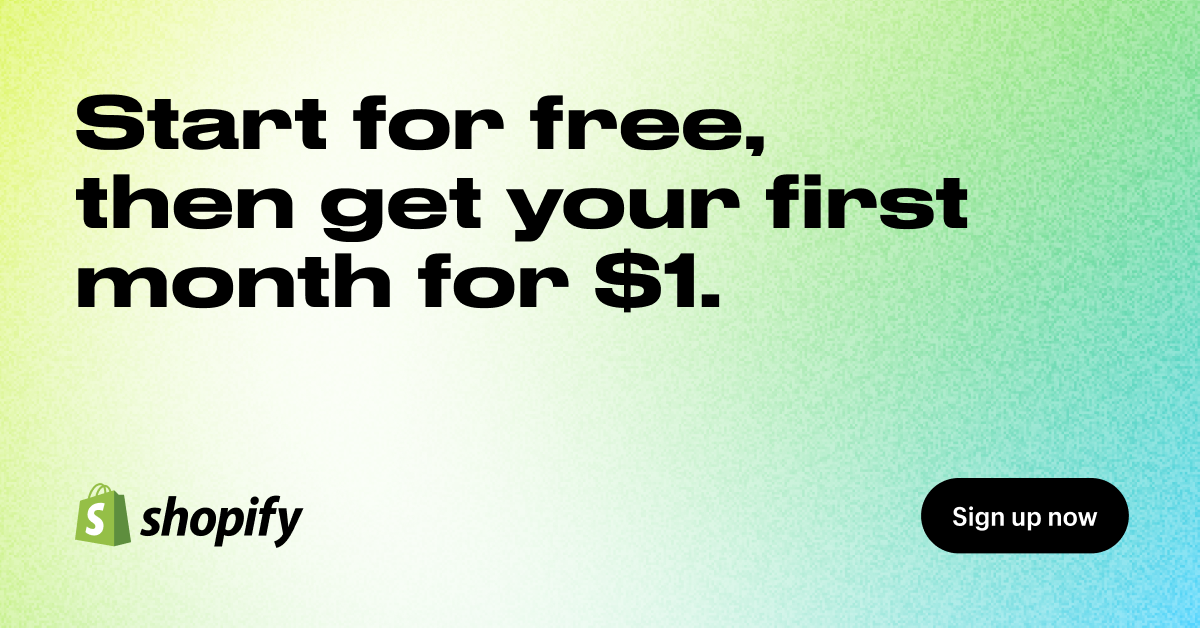Shopify vs Etsy? You must be the creative type, huh! But let me quickly get this off the table:
Whichever platform you end up choosing, it won’t be because one is better than the other. But instead, because one is more relevant and better for YOU.
You can promote your products and accept credit cards on either platform, but that’s about where the similarities end.
In this post, I will help you make a well-informed decision. And to do that, first, I will give you the high-level pros and cons of each platform. And second, I will delve deeper into the nitty-gritty by discussing ten key differences between Etsy vs Shopify.

Now, I am sure you hate long intros as much as I do.
So without any further due, let’s jump right in.
Introducing the Competitors: Etsy vs Shopify
In the orange corner, we have Etsy.

Etsy is an online marketplace designed specifically for independent creators of digital products, handmade goods & craft supplies, and collectors of unique vintage products (older than 20 years). You know that, right?
Here is something you may not know: Etsy has 2M+ users selling to 60M+ potential customers (with 40% being repeat customers) and gets 350M+ monthly user traffic. Wham!
What does all this mean? First, I can’t blame you for wanting that piece of the pie. Etsy is an undisputed leader when it comes to the handmade and craft marketplace. However, if you want to sell digital products, Etsy is also a good place to be (some people even sell feet pics!) Second, handmade types of products are inherently unique, and therefore you can bet your bottom dollar that there’s a market for your craft.
One thing that has to be crystal clear is this: Etsy is exclusively for handmade and craft creators, and those selling vintage products. So, if you aren’t one of the two, then Etsy may not be for you. You can also consider selling your handmade products on Amazon
In the green corner, we have Shopify.
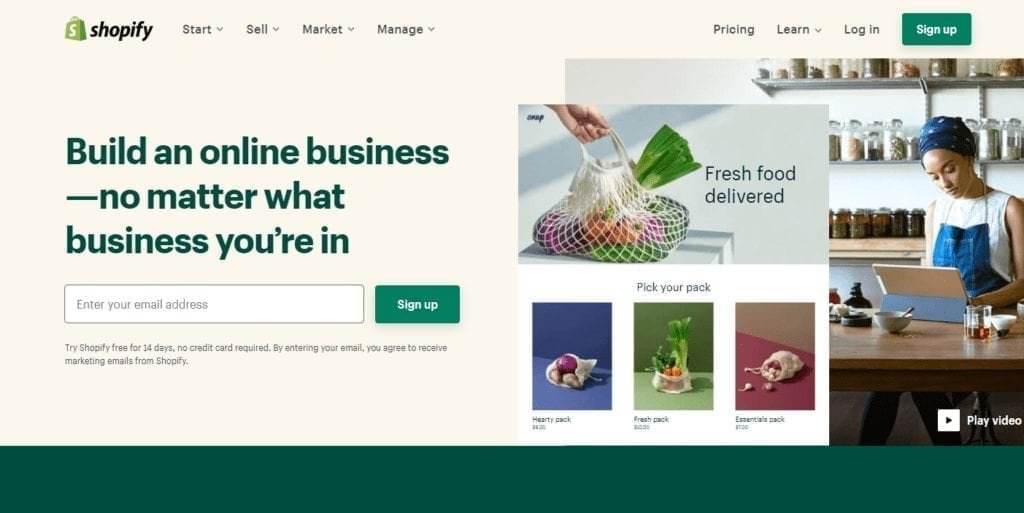
Shopify has always been something of a mystery to many people, and perhaps for the right reasons. For example, unlike Etsy, Shopify is not a marketplace, is an ecommerce platform.
What is the difference?
Marketplaces help businesses/creators sell their merchandise on their online shop under a user account, while ecommerce platforms facilitate and empower entrepreneurs to create online stores to sell on.
And perhaps that explains Shopify’s unpopularity, but do not let that fool you. Within that mystery lies a powerful ecommerce platform that already 1M+ entrepreneurs swear by.
Shopify has taken the ecommerce world by storm, and it’s not hard to see why:
They make it so easy for everyone, including Mom and Pop stores, to build an online store and compete with the “big boy” brands for online consumers. Check out our Shopify user reviews.
Etsy vs Shopify: Pros and Cons
Since Shopify and Etsy are somewhat fundamentally different, you can bet your bottom dollar that there are many pros and cons with each platform.
To be fair, these pros and cons don’t suggest that one platform is superior over the other but rather highlight the differences between them and thus making it clear which one would be the right choice for YOU.
Etsy: Pros and Cons
| Pros | Cons |
| Immediate built-in audience & traffic. While it’s not guaranteed that you’ll get any share of the traffic, it’s hard not to with 350M+ monthly eyeballs on the platform. | Competition is getting fierce. While the audience is big, there are over 2M sellers vying for the same customers. |
| Less financial risk. Etsy has already positioned their brand well and acquired traffic, which you can take advantage of without paying a cent more. | Limited brand and design control. Your hands will be tied when it comes to building a brand and customizing your storefront. |
| Reasonably easy to set up a store. If you know how to use a computer, you’ll be well qualified to set up a store with Etsy. It is that easy! | No store ownership and customer data. Etsy owns everything from your store to your customer data & relationship. |
| Brand trust and recognition. By partnering with Etsy, you’re drawing from their strong brand recognition and customer trust. | Listing and transaction fees. Etsy is not known for its friendly pricing model, but it’s not too horrible. |
| Market to a broad audience. 350M+ monthly visitors is a big, fat cake to ignore. | Limited to handmade and vintage items. You cannot sell any other things on Etsy, and therefore is only exclusive to creators and Artsy folks. |
Shopify: Pros and Cons
| Pros | Cons |
| Brand ownership. Shopify allows you to build your brand from the ground up into whatever you want it to be. | No immediate traffic. You’re 100% responsible for getting traffic to your store, which may often mean substantial financial investment. |
| Store ownership and customer data. Similar to store ownership, you get ownership of everything from the actual store to the customer list. | Learning curve. Of itself Shopify is simple. However, there are other things you have to learn like SEO (Search Engine Optimization), marketing, social media strategy, etc. |
| Scalability. With Shopify, the only limit is your imagination. Really. | Customer acquisition. Building a brand from scratch comes with creating a customer list one at a time. |
| Design Flexibility. You can customize your storefront however you like. There are thousands of apps to help with that too. | Long term strategy. Unlike Etsy, with Shopify you may often have to be patient before you can see substantial success. |
| Cost-effective pricing. Shopify offers the biggest bang for your buck, no doubt. Their entry-level price plans are feature-rich too. | On your own. In summary, that’s what you’re headed for with Shopify, but it will all be worth it in the end. |
Before I proceed to our list, there is one more thing worth noting:
Etsy Pattern
Etsy has recently launched their very own store builder called Etsy pattern. What that means is this: creators are now, not limited to selling on the marketplace, but they can also set up an independent online store using the Etsy pattern. In a way, it functions like Shopify, making it possible for makers to build their ecommerce business outside the marketplace.
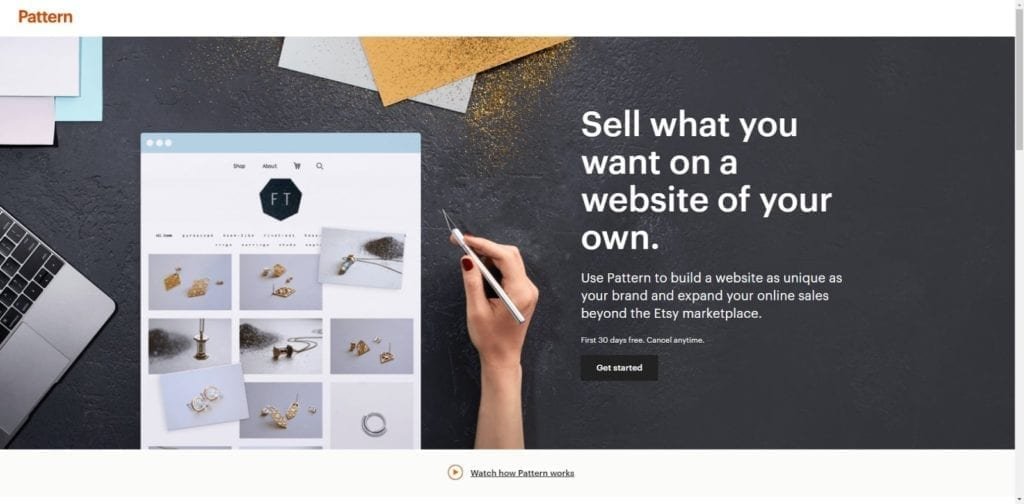
Yes, Etsy pattern is still in its maiden years but there is still a handful of things to admire, including:
- Ease of use. Like the Etsy marketplace, Etsy prides itself on an easy-to-use platform, and that hasn’t changed one bit with the new Etsy pattern. From signing in to choosing a template to create a storefront, everything is self-explanatory.
- Listing synchronization. A new sales channel doesn’t mean adding all your products from scratch. In fact, quite the opposite. Etsy pattern syncs with your Etsy shop listing, and you can choose which items to list on your online store.
- Single shop manager. No need to worry about the extra admin load that comes with running a business across multiple channels because the Etsy shop manager makes it all possible to manage both channels from a single location.
Above are some of the critical overlaps between the Etsy marketplace and Etsy pattern, but there are also some key differences to take note of, and most are positive ones:
- Sell anything. Unlike Etsy marketplace, with Etsy pattern, you can sell items beyond what you’re only allowed to sell on Etsy.
- Responsible for driving traffic. With the Etsy pattern, unlike the marketplace, you are responsible for driving traffic to your online store.
- Data ownership. When you’re selling on the Etsy marketplace, Etsy owns not only your store but your email list as well. However, that changes with the Etsy pattern. You run marketing campaigns, connect Facebook pixels, and connect Google version tracking code.
Sidenote: Although Etsy pattern is, to some extent, an independent platform, it’s important to note that you have to open a seller account and have at least one item listed with the Etsy marketplace before you can open an Etsy pattern store.
How Much Does Etsy Pattern Cost?
Etsy pattern starts at a $15 monthly cost and comes with a 30-day free trial. At this pricing, the Etsy pattern is not only affordable, compared to Shopify, but also offers plenty of time to vet it before voting with your pocket.
In two steps, you can be well on your way to setting up an online store with an Etsy pattern.
In the first step, you will be prompted to decide on the name of your store. You can choose to keep the same as your seller account or you can decide on a completely different name.
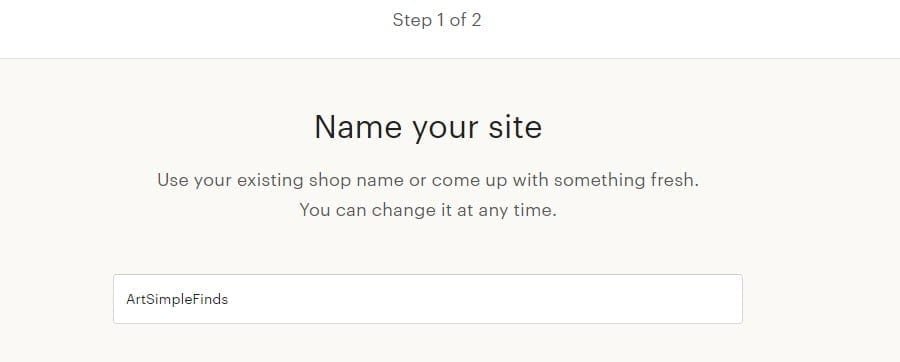
The second step involves shop customization and choosing the right theme/template for your store. Etsy offers ten free templates to choose from.
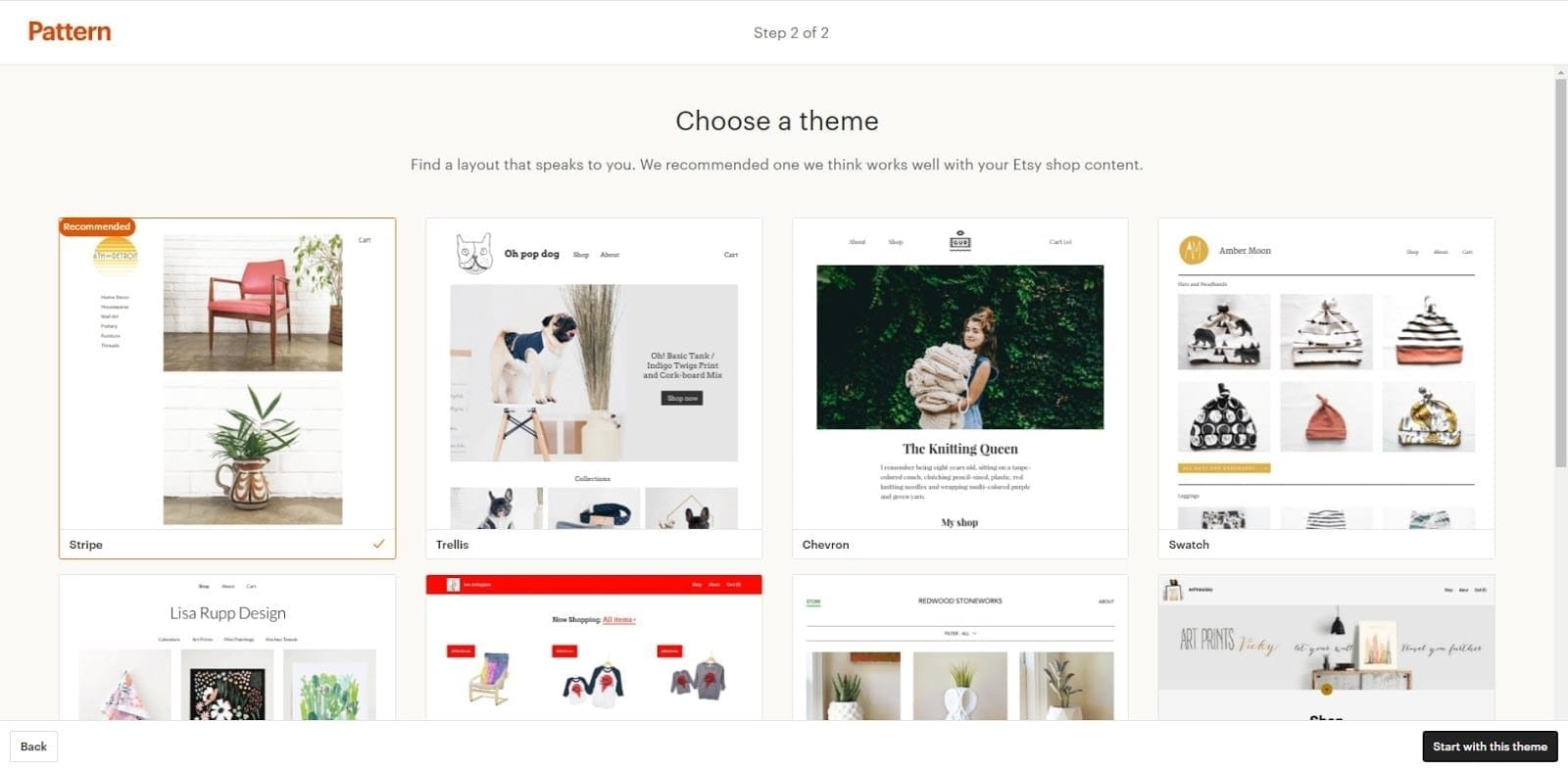
Does more templates choice mean you’re gonna have a hard time deciding the best templates for your store? Not so much. Etsy makes it easy by telling you what each template is best for. For example, some themes are best for highlighting featured products (Trellis theme), some are best for shops organized by collections (Swatch theme), and while others are simply great for bringing simplicity to your store (Stripe theme, Etsy recommended).
What about functionalities? Are there more things you can do besides setting up an online store?

As I mentioned before, Etsy pattern, like anything on Etsy, is easy to use and navigate. Once you enter the dashboard, it becomes easy to see what you can do with the Etsy pattern:
Website editor. Within the website editor, Etsy pattern allows you to add pages and design those pages at the page element level. In other words, your page and content structure is locked by the theme you choose. However, you can still change page elements such as fonts and colors. You can also change your theme at any time.

One thing I specifically liked is the ability to add reviews from your marketplace shop, and thus allowing you to quickly establish customer trust.
Blog. Etsy pattern also allows you to create and share content with their blog feature. However, I was frankly underwhelmed by the lack of the most important key features on any blog: SEO features. I shouldn’t be saying “lack” because there simply is none whatsoever. No SEO tactics like alt image, meta title & description, URL structure, etc.
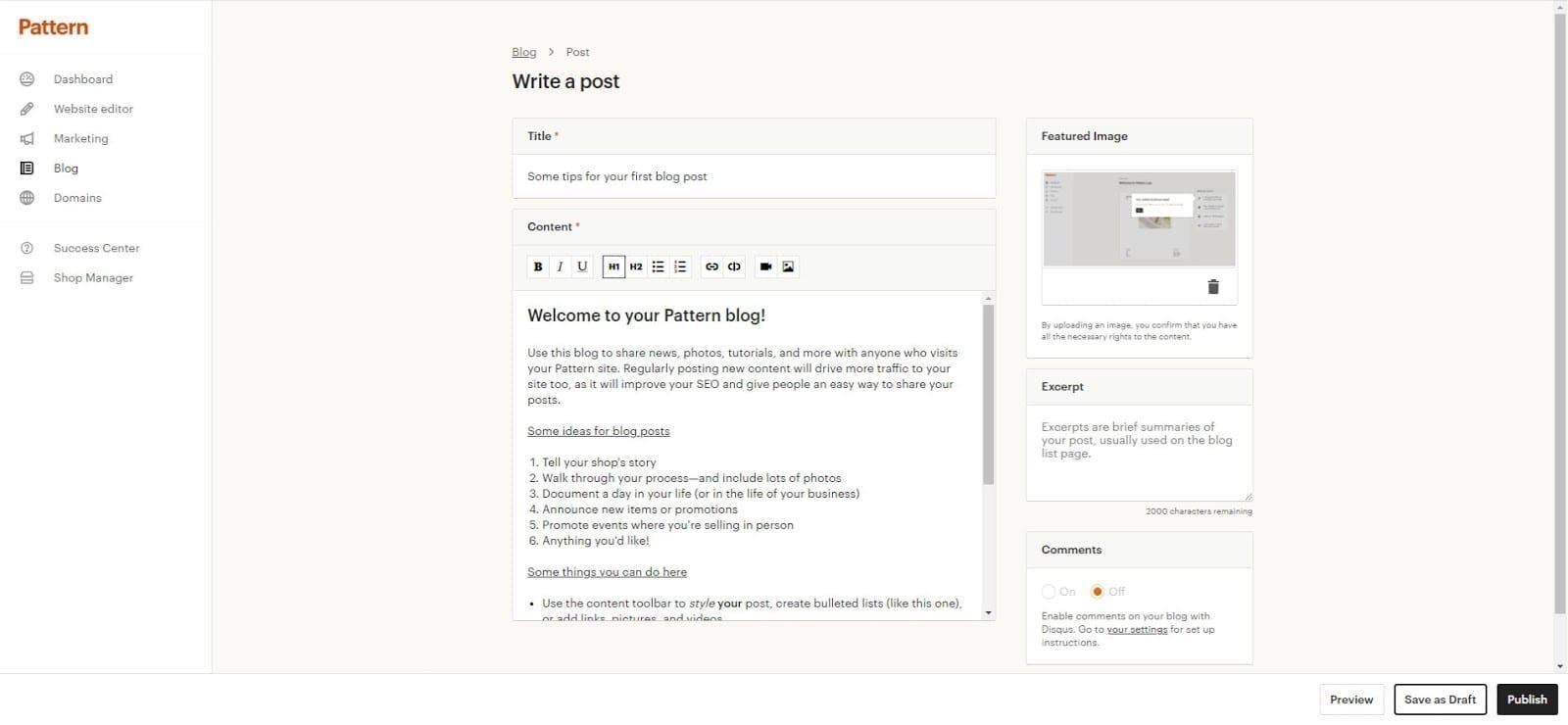
Although the editor itself has fairly decent editing options such as title tags, featured images, video embedding, etc., the lack of blogging SEO features overshadows most of the things Etsy has done well.
Marketing. Here Etsy is on the right track. You can connect your Mailchimp account for email marketing, add Pinterest & Google tracking code, and lastly, you can also add your Facebook tracking pixel.

Domain name. Lastly, from within the Etsy dashboard, you can connect your existing custom domain name or purchase many different top-level domains (TLDs). As you can see from the screenshot below, not all domain names are created equal, some are a little more pricey like .shop TLD.
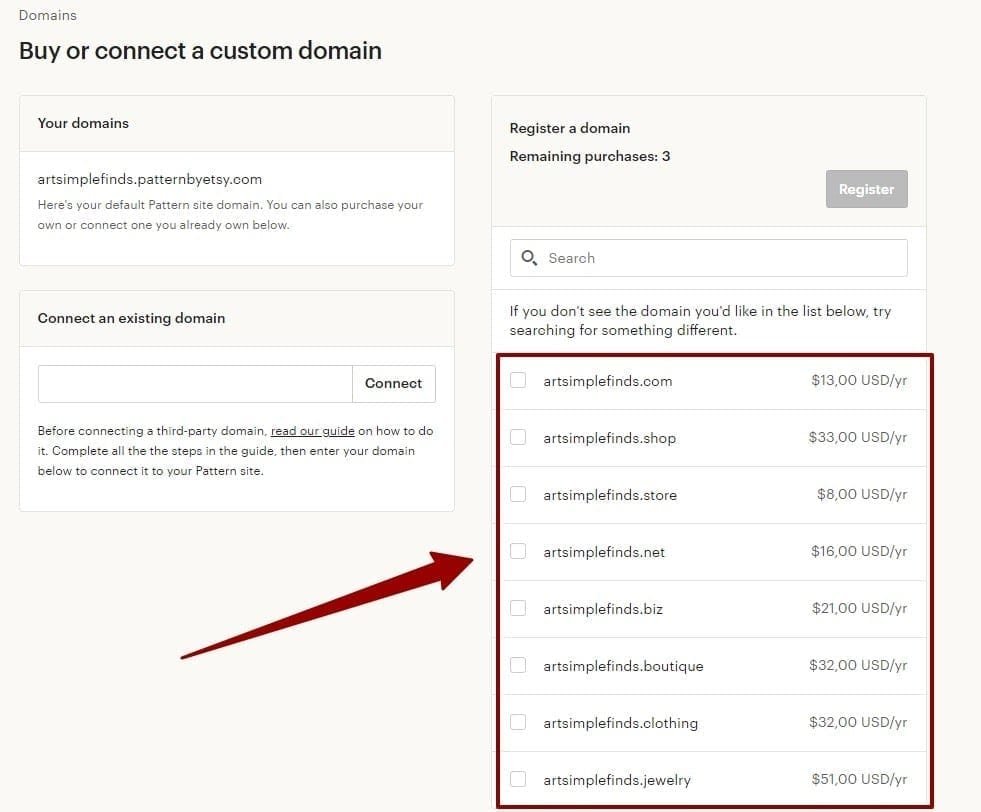
All in all, considering its recent launch, the Etsy pattern is not too bad. Besides, no platform is perfect and so the same goes for the Etsy pattern. However, for those considering opening an online store, I think you can still get a better value from dedicated e-commerce platforms like Shopify even while paying twice as much on monthly subscription fees. But if you’re on a tight budget, and would still like to open an independent store, in addition to your Etsy shop, then you may very well try out Etsy pattern. After all, you have 30 days free trial to get your toes wet before you’d have to pay.
Marketplace or ecommerce platform?
As I have mentioned before, this is one of the fundamental differences between Etsy and Shopify.
That is, Etsy is a marketplace that allows handmade creators to sell their work on the platform, while Shopify is a little different.
How different?
Shopify exists to allow businesses, solo entrepreneurs, and makers to create their very own online store through which they can sell their merchandise.
In short, this is one of the most significant differences you ought to know between the two platforms. Good to know, however, is that both platforms are beginner-friendly and cost-effective. But because of the other elements of the business that you have to learn(e.g., SEO, social media ads, blog, etc.) that come with selling on Shopify, Etsy is arguably much more comfortable to set up than Shopify.
When considering where to sell, a few thing are important to consider:
- How much time will you have available? Will you be selling in your spare time or will it be your full-time job?
- Would you like to scale your business soon after or is it simply a hobby you’d like to keep that way?
- Are you willing to take a leap and move beyond your comfort zone to learn new things?
Although these preliminary questions are by no means exhaustive, they can still help you understand how much time you have available, your long term business goals and how comfortable (or uncomfortable) you’d be with the uncertainties of running your own business.
For example, if you don’t have any plans to scale your hobby but would rather keep it small and manageable, then you’re better off selling on Etsy. But if you see yourself beyond selling more than $10 000 per year, which is what top-performing makers on Etsy make, then you may have to consider a feature beyond Etsy, even if it initially means starting there.
Etsy is ideal for launching small-scale side gig businesses off the ground. Once you find a market of hungry consumers there, you can almost be certain there are plenty of other customers to serve outside of Etsy.
But moving beyond Etsy is not for the faint-hearted. Even though opening an online store, say on Shopify, has plenty of benefits it also comes with a steep learning curve such as:
- How are you going to drive traffic to your store? Will it be through paid advertising? If so, which platform will your most customers be found on? What about the types of ads you’ll be running?
- If you’ll be driving traffic through SEO, there is a whole new world of other things to learn. What is SEO? How will I create content and how often? What about keyword research and backlink acquisition?
- Building your own Shopify store may require upfront financial investment for monthly subscriptions, marketing activities, graphic design, add-ons, etc. And many of these costs will most likely occur before you even turn in your first sale.
It’s not my intention to dissuade you but rather to info you so you can have better expectations of the challenges that come with building your online store.
Monthly Fees and Pricing
Although pricing isn’t of itself unique to either platform, it’s nonetheless significant enough to say a word or two about it and the different pricing models.
First, Etsy is free to sign up and open a seller account with Etsy standard plan. But once you sign up and start setting up your store, you’ll quickly realize the design limitations for your storefront. Under Etsy standard plan, you can only change product images, descriptions, and store logo.
Alternatively, for greater design freedom and other perks, you can sign up for the Etsy Plus plan, which starts at $10/month. The plan includes everything else in the standard plan but also offers the following perks:
- Advanced customization features. With the Plus plan you can add up to 4 customized carousel banner or collage banner over your store page.
- Out-of-stock emails. Here you have an option of sending emails to customers who may be interested in your products that were out of stock.
- Ads and domain name credit. You can get up to 50% off for .com domain names or get your .shop domain first year free.
Once you choose the plan that’s right for you, to start off I recommend Etsy Standard plan, you can now start selling. But, and it’s a big BUT, there are plenty of fees to know before you jump both feet it. In fact, there are eight types of Etsy fees that merchants have to be aware of. I will mention them here briefly:
- Listing Fees. Every time you list an item on Etsy, you get charged a fee of $0.20. Note, this is per item. In other words, if you list ten quantities of one product and sell all of them, you pay $0.20 for each ($1.00). However, if you sell multiple items as one product, you only pay $0.20.
- Transaction Fees. Etsy charges a 5% fee on every transaction (product wrapping & customization included).
- Payment Processing Fees. This should not be confused with transaction fees, it’s different and not paid to Etsy but to payment processors like PayPal or Stripe. They typically charge 2.9% + $0.30 on every transaction.
- Shipping Fees. If you charge your customers for shipping, Etsy collects 5% of the total shipping costs.
- In-Person Selling Fees. This is only applicable if you’re using the Square POS system to sell offline, but if not, it won’t be applicable. Square only charges a fee of 2.6% + $0.10 per in-person transaction.
- Etsy Pattern Fees. Again, it’s only applicable if you’re using an Etsy pattern for an online store, but if not, then you don’t need to worry about it. The monthly subscription fees cost $15/month.
- Ad Fees. Etsy makes it possible to run ads within the Etsy platform or via other channels like Google. For ads within Etsy, you get charged per click, and you can control that. But for other platforms, it’s mandatory, and the fee is between 12% and 15% for every sale.
- Currency Conversion Fees. If your listing currency and payment account currency do not match, you can expect a 2.5% currency conversion fee.
Contrary to Etsy, Shopify offers only three types of fees. Let’s see what they are:
- Subscription Fees. Shopify has a 14-day trial, but once finished, you have three subscription plans to choose from. Their entry-level plan, Basic Shopify, starts at $39/month. The Advanced Shopify plan can cost upwards of $399 per month.
- Transaction Fees. Shopify charges 2.9% + $0.30 per transaction. But if you live in the US or Canada, you have an option of using Shopify Payments which charges no additional transaction fees.
- Payment Processing Fees. This assumes you are not using Shopify payment. These fees get paid to third-party payment processors like Paypal. Costs vary but start at 2.9% + $0.50.
Now, let’s get into the nooks and crannies of Shopify pricing. Granted, Shopify is not the cheapest ecommerce platform, but for the advanced ecommerce features you get, it can somewhat be justified.
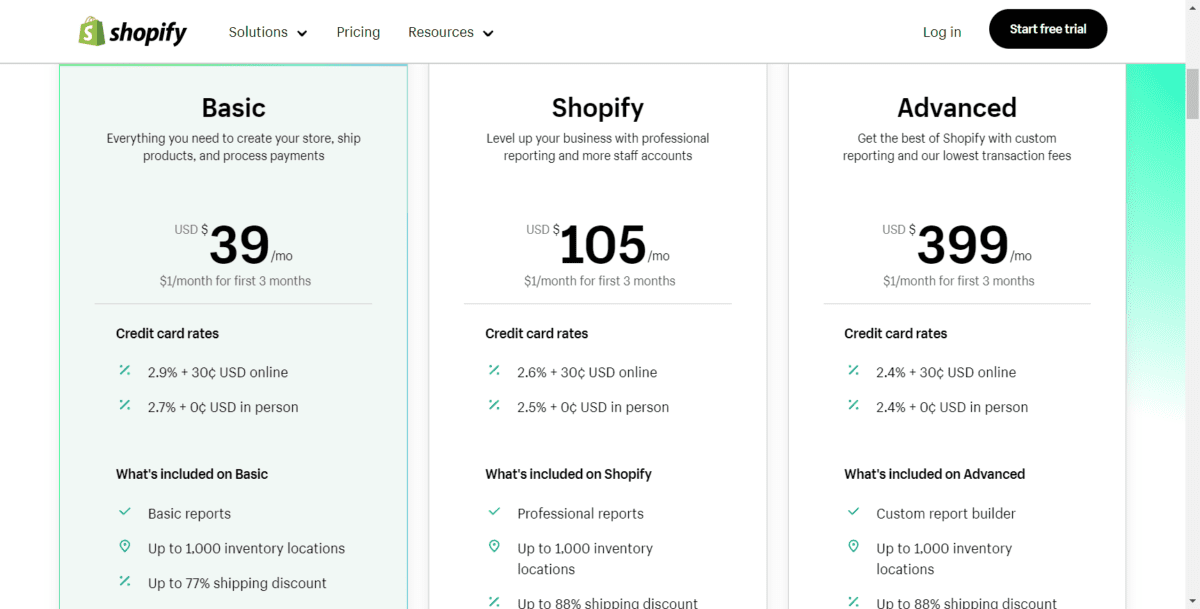
For their entry-level plan, the Shopify Basic plan starts at $39/month, twice what you would pay for Etsy pattern. But before you make a rushed decision, let me discuss additional features you get with the Shopify Basic plan that you cannot get with Etsy.
| Features | How |
| Online store | This sounds obvious, but with Shopify, you get this without paying an additional fee, unlike with Etsy, where you have to pay an extra $15/month for Etsy pattern. |
| Multi-channel sellingWith all its plans, Shopify allows you to open Facebook Shop, Instagram store, and Amazon integration, connect Pinterest tag, and even sell on Etsy. | |
| Email marketing | Shopify has recently launched Shopify email, a tool that helps you create, send and track up to 2500 emails/month for free to your email list. |
| Abandoned cart recovery | When customers leave checkout without making a purchase, you can automate email notifications to encourage them to return. |
| Coupons, discounts, and gift cards | Shopify allows you to create discount codes that apply to specific gift card products or collections to increase sales |
| Import product reviews | If you have reviews somewhere else, you can easily do so for free with the Shopify product review app. |
| Payment gateways | More than 100 payment getaways to choose from. No doubt you’ll find a gateway that works great for your customers. |
| Shipping discounts | You can earn up to 64% discounts on shipping, and even more (up to 74%) on their high-tiered plan. |
| Shopify POS | Accept in-person payments at farmer’s markets, fares, popup stores, etc. |
| Third-party apps | Added functionality with third-party apps, many of them with free plans. |
Above are features I deemed important to mention but frankly, there are yet more features that can justify Shopify’s starting price of $29/month.
Next up, you have Shopify’s pro plans which are specifically curated for growing businesses. For starting out on Shopify for the first time, Shopify’s entry plan almost always suffices. It’s very among small business owners, solo entrepreneurs, and dropshipping businesses. Here are the three main differences between the Shopify Basic plan and the other pro plans.
- Real-time shipping rates. Shopify Basic plan doesn’t come with this feature. This feature allows you to the most accurate rates for your customers without under or over-charging.
- Advanced reports. Shopify Basic’s reports are…basic. For more advanced reporting for metrics such as sales, customer and profit report you may need to upgrade.
- Shipping discounts. The higher the plan, the lower the discounted shipping rates. Plus, pro plans allow you to integrate with your own third-party shipping account.
As you can see, even though some fees are conditional, there are a lot more fees than advertised on both platforms. And that’s one of the things you’ve got to be aware of.
Audience and Traffic Source
Etsy has over 350M visitors to its platform every month, and of that number, 40% of them are repeat customers. As such, it’s not hard to see why so many entrepreneurs and creators are attracted to online selling on marketplaces.
With the traffic already there, and with a unique value proposition, makers can position themselves to get in on the action. And that is one of the most significant advantages of Etsy over Shopify or any of its alternatives.
Conversely, as a creator starting on Shopify, one of the biggest hurdles you’ll have to face is driving traffic to your online business.
This can take many shapes or forms. You could either choose to run ads on Google, Social media (Facebook, Pinterest, etc.) or take advantage of free Google traffic by optimizing your site (SEO). None of these tactics are by any means easy, but once you get them right, your growth potential will be limitless.
My recommendation? If you’re an independent creator and have little to no experience selling online, I would recommend you get your toes wet first with Etsy, once you feel confident with your product, then you can consider opening an online store with Shopify. However, if you’re somewhat experienced with selling online, and you know what marketing, SEO, ads, etc., then I am confident you can make it on Shopify.
Brand Exposure and Customer Trust
This point ties in well with the previous one. Many people know of Etsy, and when they’re looking to buy a unique gift or handmade item, Etsy naturally comes to mind.
Etsy is trusted and has a good brand reputation, which rubs off on the creators selling there. As a new creator, you can benefit from this customer base and trust from day one.
However, I would be doing you a disservice not to point out that for new sellers, it’s not always peaches and creams. Your new Etsy listing, no matter how unique, will most likely be buried within 100s or 1000s of other similar listings from older stores. In fact, Etsy’s algorithm is designed specifically to prioritize older stores.
While selling through Shopify is “no darling” by any means, the possibilities are endless, and the only ceiling is the one you set for yourself. Online sales have seen a 32% increase this year alone in the United States alone. At this rate, more and more people will continue shopping online, and if your brand doesn’t ride the wave of ecommerce sooner rather than later, you may be leaving money on the table.
Shopify, as such, is well positioned not only to benefit from this ecommerce revolution but help millions of small businesses and makers like you to competitively sell online without having to worry about expensive software development costs associated with building ecommerce software from scratch.
Using Etsy
Etsy is not a platform to build your brand but rather a platform to give your brand early exposure and test out your unique value proposition.
If that isn’t readily evident, you will quickly come to realize the design limitations when you try to tweak and twist your Etsy store. There are only a few things that can set apart your own website from millions of other ecommerce websites:
- Store Name & Brand Logo. Etsy allows you to add your logo to your store to set yourself apart from other makers.
- Product Images & Descriptions. One of the first things visitors will see, and be attracted to, is your professional product images and a catchy product description. If you get these two right, you’re well ahead of the competition.
I have to point out, however, that design freedom isn’t always bad. One of the pros it presents is that your store will follow Etsy’s design and layout – clean, modern, and attractive.
Listing an item on Etsy is fairly straightforward. It follows the same four templated steps that include:
- Step 1 – Add Listing Media: Here, you can add your listing images and videos.
- Step 2 – Listing Details: Product name, descriptions, type, category, etc.
- Step 3 – Inventory & pricing: Here, you get to indicate how much of each item you have in stock, the variants and price of each item, and even the personalization info box.
- Step 4 – Shipping: Set real and clear shipping expectations, processing times, prices, shipping locations, and shipping services.
While you can do these on a browser, you can conveniently do them on Etsy mobile app as well. The app is designed to serve both buyers and merchants. For sellers, you can access shop stats, and orders and create and manage listings.
Using Shopify
On the other end, Shopify allows you to build and create your online store however you like. Their elegantly designed themes offer plenty of customizations compared to Etsy. From their collection of 12 free themes and more than 60 premium themes, you can be sure you’ll find a template that meets your needs.
Should that not be the case, Shopify has the biggest 3rd-party app store of any ecommerce platform. Some apps are free, while others are premium, but most apps are freemium; that is, even while they have paid plans, they still have a free plan with limited features.
Like Etsy, Shopify also has a mobile app that allows you to do a host of different things, including:
- Manage and fulfill orders
- Create and edit product listings
- Access different sales channels
- Connect and communicate with your customers
Selling On Etsy Vs Shopify
In recent years, Etsy has been partnering with sites like Google, Facebook, Pinterest, Twitter, and Bing to advertise your products on these platforms automatically. Now, before you get alarmed, I think it’s a great thing, and here is why:
- First, there are no upfront costs to you; that is, you only pay an advertising fee (12% or 15% depending on your YoY sales) when you make a sale, not a click. For example, if you get 100 clicks to your store but don’t make a single sale, you won’t pay a penny.
- Second, you get long term brand exposure. The more clicks you get to your store, the greater the likelihood of closing a sale and repeat sales from the same customers. And none of this is at any upfront cost to you; you only pay when you make a sale.
Note that all sellers are enrolled automatically but sellers but those with sales less than $10 000 per year can opt-out if they wish to. But for anyone else is mandatory.
I think it’s a win-win arrangement, especially if you have a decent mark-up on your products. But either way, a 15% ads fee for a sale you haven’t lifted a finger on it’s hard to beat.
Although Shopify allows you to sell on these platforms, and plenty of others, you can decide to opt-in or out of Shopify’s dynamic ads.
If there is a takeaway to point out, is this:
Both platforms offer plenty of opportunities to expand your reach and acquire new customers. Shopify is much more flexible and allows you to sell on platforms like Facebook, Pinterest, Google, Amazon, eBay, Instagram, etc. Best part? You can sell on Etsy too.
Etsy Shopify Integration
To connect your Etsy shop to Shopify, you must have goods listed on Etsy already. Then go to Shopify and download the Etsy Marketplace Integration app. Locate the “Connect with Etsy” text block on the app’s homepage, insert your store name, and hit Enter. On the next page, select “Allow Access”, and now your Shopify store will be linked with Etsy.
Store Ownership
There are many benefits to selling on marketplaces, but there are also drawbacks that can limit your growth. And one of these limitations is the fact that you’re like a renter on these platforms. If you get on the wrong side of the Landlord, you can be kicked just as fast.
Etsy, like other marketplaces, owns everything. That includes customer data & relationships and the very own store you’re selling on. Also, Etsy can make changes to its SEO algorithm without notice, potentially affecting your sales overnight.
While this may sound far-fetched, the truth is that marketplaces don’t exist to help you but to help themselves. They want the focus to be on the products, not the sellers.
When you’re starting out, lack of data and store ownership may not sound too bad as long as sales are coming in, right? But once the time to scale comes, you’ll soon realize that when it comes to online marketing, data is the new gold and without it, your hands will be tied.
If you want to be in control of your brand, you need your store on your own domain.
This kind of setting is one of the biggest reasons why many sellers may want to start their online store on Shopify so they can be in control – control of customer list, marketing, and store itself.
After all, it was upon this premise that Shopify was first created- “make commerce better for everyone, so businesses can focus on what they do best: building and selling their products.”
FAQs
That’s it, folks!
Enough ranting for the day, huh. I hope this has been at least somewhat helpful. Something I haven’t mentioned in this article is that these two platforms aren’t mutually exclusive. That is, choosing Etsy for example, doesn’t mean you can’t use Shopify at the same time. The opposite is true as well.
But be sure not to bite more than you chew. If you’re a creator just starting, I would recommend you test Etsy out first to get a feel of the market. But if you’re an existing Etsy seller and want to step up your game, Shopify may be the next natural step to take.
Shopify is a more established website builder. The Shopify app store has endless extensions, plus you will get great support from live chat and the Shopify help center.
Have any questions or comments regarding Shopify or Etsy? Be sure to leave them in the comment section below. I will try my best to respond to each one. Cheers!
